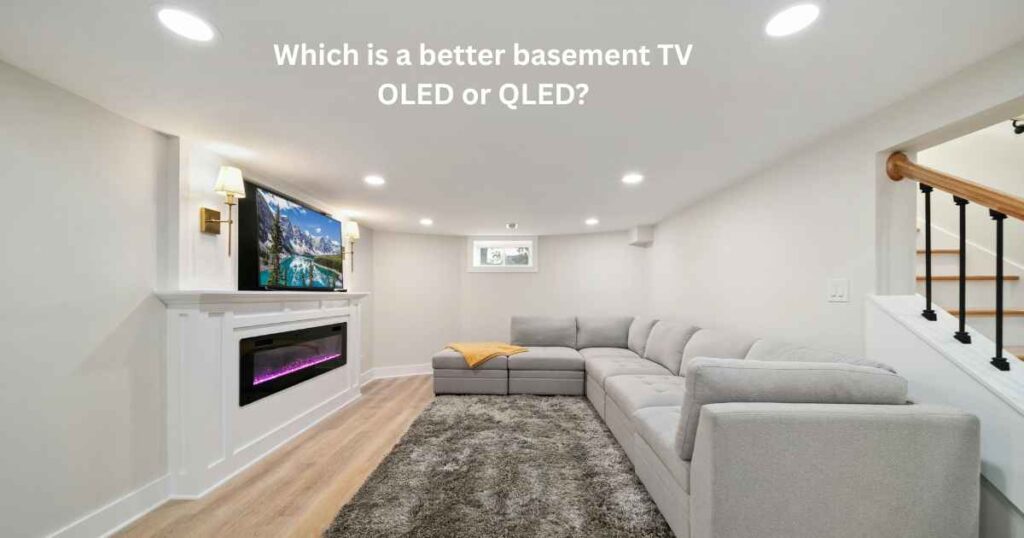OLED vs QLED: Which TV is better for basement?
What if I transformed my basement into a home theater?

The basement is often the area of the house we tend to overlook but it has great potential for many uses.
For instance, if you have a spacious, empty basement, you can convert it into a home theater by buying an OLED or a QLED TV.
For that, you first need to renovate the space to make it more inviting and comfortable.
Generally, the basement is a secluded part of the home, lacking the natural sunlight that fills your living room.
But this can actually work to your advantage!
Advantages of converting your basement into a TV room
- No external light: With minimal or no windows, you won’t have to worry about sunlight glare or reflections.
- Quiet environment: The basement’s isolation means little to no outside noise, providing a peaceful environment for watching TV.
- Minimal disturbance: The sound from your TV won’t disrupt other family members, giving you a space to enjoy your shows without bothering anyone.
- Complete privacy: A dedicated space to watch your favorite content, without interruptions or distractions.
Now that you’re ready to transform your basement into a TV room or even a home theater, let’s talk about choosing the perfect TV out of QLED and OLED for the space.
OLED vs QLED: Which is a better TV for your basement?
What is QLED?
QLED, short for quantum dot-LED, is a type of traditional LED-backlit LCD TV that uses a layer of quantum dots to enhance color reproduction.
The LED backlight emits white light that passes through the quantum dot layer, which then produces pure monochromatic colors.
These pure colors combine to form a wide range of hues on the screen.
QLED TVs use local dimming, where the LED backlight is divided into multiple dimming zones that adjust brightness independently across different areas of the screen.
The overall picture quality of a QLED largely depends on how many dimming zones it has—the more zones, the better the contrast and black levels.
Thanks to its powerful LED backlight, a QLED TV can achieve very high brightness levels, making it very effective at combating glare in brightly lit rooms.
What is OLED?
OLED stands for organic-light emitting diode.
Unlike LCD TVs, it uses a completely different technology that doesn’t rely on a backlight.
It features self-emissive organic pixels embedded directly in the display.
Each pixel acts as its own light source and can switch on or off independently.
This allows the screen to achieve true blacks, as individual pixels can completely shut off when no light is needed.
Now that we have a quick introduction to both the technologies, let’s break down the key requirements for a TV to be best suited for a basement.
Key requirements for a basement TV
- Decent Brightness: Since there’s little to no sunlight or glare in a basement, the TV doesn’t need extremely high brightness. It should be just enough for a comfortable viewing experience under artificial lighting.
- Pure Blacks & High Contrast: To enhance realism and make colors pop, the TV must produce deep, pure blacks. This will elevate shadow detail and provide an overall immersive experience, especially in darker scenes.
- Wide Viewing Angles: No matter where your family members are seated — center, side, or corner — the picture quality should remain consistent, without color shift or brightness loss.
- Fast Response: For using the space as a theater-cum-gaming room, a TV with low input lag and fast pixel response is essential for smooth motion, quick transitions, and blur-free action in fast-paced content.
OLED vs QLED: Which TV is better for a basement?
As we have discussed earlier, a basement is generally a closed-off area, unlike a living room that often has open curtains or windows allowing sunlight to enter.
As a result, there’s little to no natural glare to contend with.
Additionally, the lighting in a basement is entirely under your control — you can keep it bright or dim as per your requirement.
In a dark room like a basement, an OLED TV delivers an unmatched performance.
Its infinite contrast ratio and ability to display bright, vivid colors against pitch-black backgrounds take the viewing experience to an entirely new level.
For instance, in a night scene, bright stars appear crisp and sharp, almost as if they’re painted into the darkness, with no blooming or haloing around them.
OLEDs also offer exceptional viewing angles, which means that the picture quality remains consistent no matter where you’re seated, without any color distortion.
Thanks to their self-lit pixels rather than a backlight, OLEDs achieve an incredibly fast response time of around 0.1 milliseconds.
This ultra-quick responsiveness will delight you when playing fast-paced, action-heavy titles.
When it comes to performance in a dark room, a QLED TV generally doesn’t come close to matching an OLED.
This is mainly due to the large difference in contrast ratios. OLED TVs offer infinite contrast, while QLEDs have a much lower contrast ratio.
As a result, blacks on a QLED TV can appear slightly greyish or washed out.
That said, many modern QLED TVs now incorporate mini-LED backlighting, which significantly improves contrast by allowing more precise control over localized dimming.
A mini-LED-backlit QLED, with thousands of dimming zones, can get closer to OLED-like contrast.
However, it’s still not perfect like an OLED.
You may still notice some blooming, a faint halo effect where light from bright objects bleeds into adjacent dark areas.
This happens because a QLED relies on an always-on backlight, which continues to glow even when a specific part of the image should be completely dark.
Now, let’s recap how OLED or QLED TVs match the requirements of a basement TV.
How do OLED and QLED match the requirements of a basement TV?
| Requirement | OLED | QLED |
| Decent Brightness | 👍 👍 Yes — OLEDs are bright enough for basement lighting. | 👍👍 Yes — QLEDs are generally brighter, but that’s not a big necessity in a basement. |
| Pure Blacks & High Contrast | 👍 👍 Excellent — Self-lit pixels achieve perfect blacks and infinite contrast, ideal for dark scenes. | 👍 Moderate — Even with mini-LED backlighting, blacks may appear greyish with some blooming still present. |
| Wide Viewing Angles | 👍 👍 Outstanding — Picture remains consistent from any angle. | 👎 Limited — Viewing angles are narrower; some color and brightness shift off-axis. |
| Fast Response | 👍 👍 Exceptional — ~0.1 ms response time is perfect for gaming. | 👎 Slower — Slower than OLED; not ideal for high-speed gaming. |
Conclusion
OLED clearly outperforms QLED for a basement TV in nearly every key area, especially contrast, viewing angles, and response time.
While QLEDs are generally brighter, that advantage isn’t that much necessary in a controlled-lighting basement setup.
Thus, OLED is the ideal choice for a basement TV.
With an OLED, you can easily transform your basement into a theatre cum gaming room.
The larger the screen size, say 65 or 75 inches, the more immersive your experience becomes, pulling you deeper into your favorite movies, shows, or games.
However, those large-sized OLED TVs can be quite expensive.
If you’re looking to save some money, a good mini-LED TV with quantum dots can be a solid alternative, offering high brightness and good contrast.
But if top-notch picture quality is your priority, there’s no question — go for an OLED.
Note: Other important features, such as high resolution, HDMI 2.1 ports, high refresh rates, VRR and ALLM support, as well as Dolby Atmos and Dolby Vision compatibility—are commonly available in both premium QLED and OLED TVs. Each of them offers a wide color gamut and delivers strong HDR performance.
Additional Tips: Consider investing in a soundbar or a full surround sound system for a more immersive, theater-like audio experience without any echo. This is important especially in larger spaces like basements where TV speakers alone may not be sufficient. Moreover, check for any structural issues such as wall or ceiling leaks, which may affect both your TV and viewing comfort. Proper insulation and moisture control are crucial for a quality viewing experience in a basement setup.


